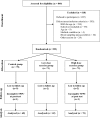Exercise effects on depressive symptoms and self-worth in overweight children: a randomized controlled trial
- PMID: 19223278
- PMCID: PMC2744328
- DOI: 10.1093/jpepsy/jsp007
Exercise effects on depressive symptoms and self-worth in overweight children: a randomized controlled trial
Abstract
Objective: To test the dose-response effects of an exercise program on depressive symptoms and self-worth in children.
Method: Overweight, sedentary children (N = 207, 7-11 years, 58% male, 59% Black) were randomly assigned to low or high dose (20 or 40 min/day) aerobic exercise programs (13 +/- 1.6 weeks), or control group. Children completed the Reynolds Child Depression Scale and Self-Perception Profile for Children at baseline and posttest.
Results: A dose-response benefit of exercise was detected for depressive symptoms. A race x group interaction showed only White children's global self-worth (GSW) improved. There was some evidence that increased self-worth mediated the effect on depressive symptoms.
Conclusions: This study shows dose-response benefits of exercise on depressive symptoms and self-worth in children. However, Blacks did not show increased GSW in response to the intervention. Results provide some support for mediation of the effect of exercise on depressive symptoms via self-worth.
Figures



References
-
- Annesi J. Improvements in self-concept associated with reductions in negative mood in preadolescents enrolled in an after-school physical activity program. Psychological Reports. 2005;97:400–404. - PubMed
-
- Bailey RC, Olson J, Pepper SL, Porszasz J, Barstow TJ, Cooper DM. The level and tempo of children's physical activities: an observational study. Medicine And Science In Sports And Exercise. 1995;27:1033–1041. - PubMed
-
- Barlow SE. Expert committee recommendations regarding the prevention, assessment, and treatment of child and adolescent overweight and obesity: summary report. Pediatrics. 2007;120(Suppl 4):S164–S192. - PubMed
-
- Baron R, Kenny D. The moderator–mediator variable distinction in social psychological research: conceptual, strategic, and statistical considerations. Journal Of Personality And Social Psychology. 1986;51:1173–1182. - PubMed
-
- Bell LM, Byrne S, Thompson A, Ratnam N, Blair E, Bulsara M, et al. Increasing body mass index z-score is continuously associated with complications of overweight in children, even in the healthy weight range. The Journal Of Clinical Endocrinology And Metabolism. 2007;92:517–522. - PubMed

